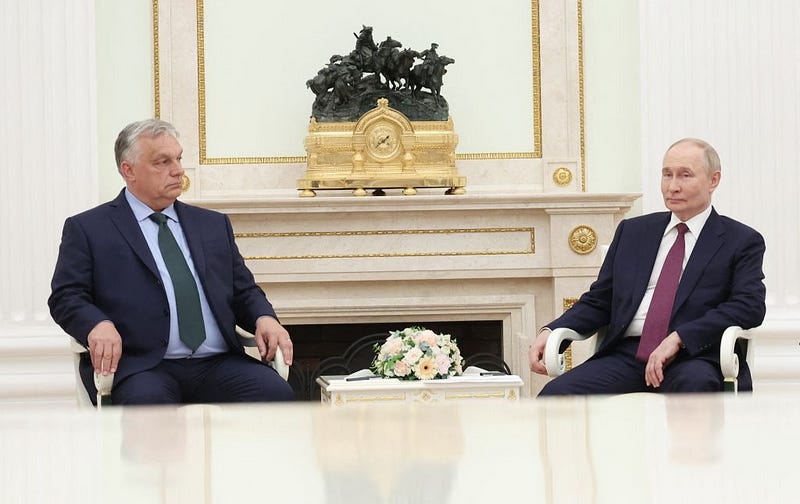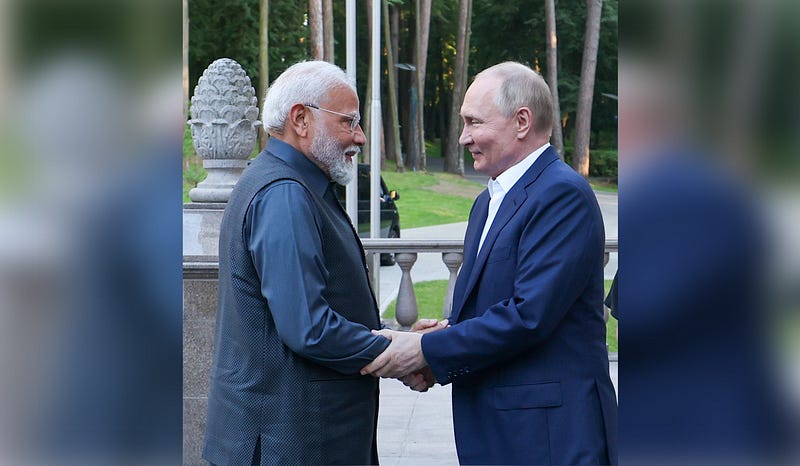Modi and Orban in Moscow — Reasons and Implications
Indian Prime Minister Narendra Modi made the first bilateral international visit of his third tenure to Russia on July 7 and met with the…
Indian Prime Minister Narendra Modi made the first bilateral international visit of his third tenure to Russia on July 7 and met with the Russian President Vladimir Putin. This is a significant deviation from his foreign policy. Historically, the first visits that Indian Prime Ministers have made are to India’s neighbouring states, like Bhutan, Nepal, Sri Lanka, Bangladesh, and Maldives. This is a very important development for Russia, India, and Ukraine.
Viktor Orban, President of Hungary, also visited Moscow a few days before Modi, becoming the first Western State Leader to visit Moscow since April 2022. It comes days after Orban visited Kyiv, and not long after Hungary had only recently acquired the rotating presidency of the Council of the European Union. He was a very liberal-leaning leader for a very long time.
Orban’s visit:

Viktor Orban has often been accused of being a Kremlin stooge. Orban has consistently blocked a unified EU stand against Russia. It is important to note that this change in Orban’s attitude has been only in the past 8 to 20 years. In 1989, Orban called for the USSR to withdraw its troops from Hungary and called for multiparty elections. He was the one who led Hungary’s integration into the Western-led World Order, and Western institutions, like NATO and the EU. With these accolades under his belt, he would have been considered a liberal leader. This change in tones and attitude has been in the works for a long time. He opposed sanctions against Russia after the 2014 annexation of Crimea, awarded contracts to the Russian company ROSATOM to construct 2 Nuclear reactors in Paks in 2014, well after Crimea was annexed, without floating a public tender. Budapest and Moscow signed a deal that allowed Hungary to import Russian gas at less than market rates through routes that bypass Ukraine, depriving Ukraine of transit fees. Within the EU too, a Poland-Hungary anti-liberal axis was formed. Budapest also aligned itself with Warsaw when it came to opposing EU demands, especially on abortion, migration, rule-of-law, and LGBTQ Rights. However, not all is sunshine and rainbows for Moscow. ROSATOM was not given a construction permit for Paks until they provided documentation that met EU standards.Budapest has expelled at least ten Russian intelligence operatives from the country without publicity since 2010. Orban used the concessions offered to him by Putin to come back to power for example through lower gas and energy prices.
However, Orban’s visit to Moscow diminishes the notion that Putin is internationally isolated. His visit to Putin undermines Western unity and legitimizes Vladimir Putin’s actions (war crimes) in Ukraine. Western leaders have been steadfast in their refusal to meet Putin since the beginning of the invasion, unless his forces withdraw from Ukraine. What makes this worse is that it is an EU and NATO leader who has visited Moscow and met Putin. The situation in Ukraine was on the agenda of discussion, with Orban attempting to style himself as a mediator and negotiator. EU Leaders, including the Dutch and the Polish Prime Ministers stating that Orban was not a spokesman for the EU. However, this attempt by Orban has fallen flat on its face. Putin laid out unacceptable terms for a ceasefire followed by peace talks. For a ceasefire, Ukraine would need to withdraw its troops out of Donetsk, Luhansk, Zaporizhzhia, and Kherson, essentially abandoning all the defensive lines constructed over the past 2.5 years. From Kyiv’s perspective, this is complete capitulation to Putin.
Orban, however, has been very clever in his interactions with the media. He insisted that based on his conversation with Putin, he was convinced that Russia and Hungary had very different positions on Ukraine, without revealing specifics of what they had discussed. His visit, however, has undeniably damaged Hungary’s foreign relations. The axis with Poland has been destroyed, as Poland has arguably been the most pro-Ukrainian state. Poland has since improved ties with the Baltics, with Finland, and with Romania.
The Modi-Putin meeting.

Modi visited Moscow and held talks with Putin on July 8 and July 9, 3 days after Orban. Modi’s reason for visiting Russia can be explained in one word — ‘China’. Countering China is an absolute necessity for New Delhi. Moscow has been compelled to supply oil and natural gas to Beijing at lower than market prices. New Delhi had one trump card over Beijing, and that was the ability to restrict its shipping via the Malacca Straits, where a large amount of its oil is shipped from. Now, this strategic advantage has been mitigated. With this visit, Modi aims to offer Putin an alternative pole that it can use to reduce its dependence on China. This has also raised eyebrows in the West. Eric Garcetti, the US Ambassador to India, stated that Indo-US ties must not be taken for granted. This was a veiled message for the Indian leadership. Modi, who was recently re-elected, won fewer seats than the previous election, and less than a simple majority. He has a lot to worry about, including maintaining his government, expanding military, economic and technological ties with the West, countering China, and ensuring deliveries of spare parts for existing equipment from Russia. With the agreement between Putin and Kim Jong Un, the Supreme Leader of North Korea, Russia fully cut off its other partner in diversification away from China, ie, South Korea. Modi understands this and realizes the need to offer Russia another way out from 100% reliance on China. It is for this reason that Indian companies haven’t ended their operations in Russia, and India has been attempting to increase its exports to Russia and bridge the trade deficit. That would actually make rupee-ruble trade actually feasible, which is something New Delhi and Moscow both desire. Both also have limitations, such as New Delhi’s reluctance to trade in the Chinese Yuan, and Moscow’s desire to rely less on Beijing. Moscow wanted to import different types of industrial goods, like parts for cars, trains, and aircraft, heavy machinery, and telecommunications equipment, that it cannot source from the West due to sanctions. There is, however, little data on whether these parts have been exported or not. Traders and businessmen would like to stay silent on this trade, lest they be sanctioned by the Western states too.
Together, both of these visits have had one impact — to diminish the image that Moscow is internationally isolated, an image that the West is very keen to paint. However, war fatigue in the rest of the world and interests driven by cheaper access to Russian resources are what have driven a lot of states to continue trading with Molscow, albeit having to resort to more creative methods of payments.



